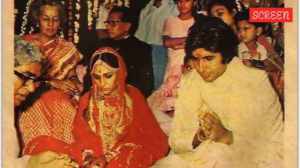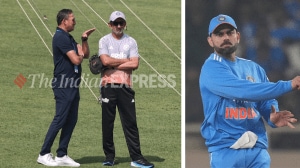The Michal mission
EXPRESS NEWSLINE®At 46, Michal Ronan Safdie presents the contemporary face of a "woman of substance". An adoring wife, ...

EXPRESS NEWSLINE®At 46, Michal Ronan Safdie presents the contemporary face of a "woman of substance". An adoring wife, a devoted mother of two teenage girls, a conscientious housewife and a consummate photographer, Michal comes across as a gentle concerned human being. And it is this humane aspect which is the leitmotif of her work. With a large glossy book under her belt centering around the Wailing Wall of Jerusalem, Michal simply drifted into the project two years ago, when she moved with her two daughters from Boston to Jerusalem, for a year, in order to acquaint her daughters with Jewish culture. "I wanted them to learn the language and the culture, get close to the people and the land. It was than that I started work with the book. Unfortunately, I started only towards the end of my stay."
Michal began by photographing the graffiti on the Wall of Jerusalem, by the right-wing extremist Israelis. "It was extremely disturbing. If you can write like that about your neighbours it would not be long before it happens at home, and true enough it was the time when Prime Minister Rabin was assassinated by these extreme right-wing people."
Michal lives for nine months of the year in Boston, and the Safdies also have a home in Jerusalem. Very much a product of the strife-torn Israel, Michal is a post-graduate in Sociology. After completing her compulsory army training, she met her architect husband Moshe Safdie, when she was 20, and started doing photography. Michal has not had any formal training in photography, she learnt it on the job. "To learn photography, you have to actually do it. The more you do, the better you get. I began by photographing architectural models. I opted to work with Moshe so that I could also devote time to the girls."
Michal did not want to suffer the guilt pangs that her artist mother had when she used to leave Michal and her sister for days on end in the course of her work. "My mother was an enamel artist and I remember she went off to Switzerland for 15 days leaving us alone. It wasnot usual in the 60s to leave the children alone with her father. But, my sister and I never felt any neglect. In fact, we were very proud of our mother’s work, in the same way my children are of my work. They are extremely supportive of my work."
Michal is here on her latest venture. She is photographing "90 plus" women and connecting them with events in history. The women need not be celebrities. "They can be ordinary women who are closer to hundred. For, as we near the close of the century, these women who are also nearing the end of their century, have a story to tell, and that is what is important. In the course of telling their story, they have their own experiences which are part of history."
Michal till now has managed to interview about 18 women mainly from the West, and the Middle-East, but not any from S-E Asia or the Far-East. She was to go to China earlier this year, but a bout of pneumonia prevented her from doing so. This project started in Mexico. And while photographing the "90 plus" women, Michal herself has embarked on a new journey of discovery.
While taking the pictures, she is also interviewing them and that is fascinating Michal. The faces of the women have their own story to tell. There is a 90-year-old who is worn and weary, there is one 90-year-old whose eyes are sparkling, for whom life is a many splendoured thing. There are women and women, for Michal. Some who are tired of life and some who are discovering life. "I am very interested in women. I managed to trace a woman who was on the Titanic, but she does not want to talk to me. This lady lost her twin brother, her elder brother and father in the disaster, and till date does not want to talk about it. I have also noticed another peculiar trait amongst women, all the women I have talked to – when it comes to talking about the death of their parents, they talk about their death as if it happened just yesterday."
Along with this project, Michal is simultaneously working on another project, that of trees. She is shooting those trees in which she sees a human form. When it’s not women, then it is trees that Michal is shooting.
The present assignment means a lot of travel for Michal, and she coincides it when husband Moshe is at home so the girls have at least one parent with them. Things are a little easier, since the girls are a little grown-up and can manage on their own as they are doing now, when both parents are here in India. "A friend is staying with them right now so I am relaxed."
Personally, she prefers to use two cameras, both Nikons, one a Nikon 2000 and the other an ordinary one. Sometimes, Michal also uses the state-of-the-art Hasselblad, "but only when I am using the tripod, for it is cumbersome to carry". Michal prefers to take her pictures in natural light without artificial light.
- 01
- 02
- 03
- 04
- 05































